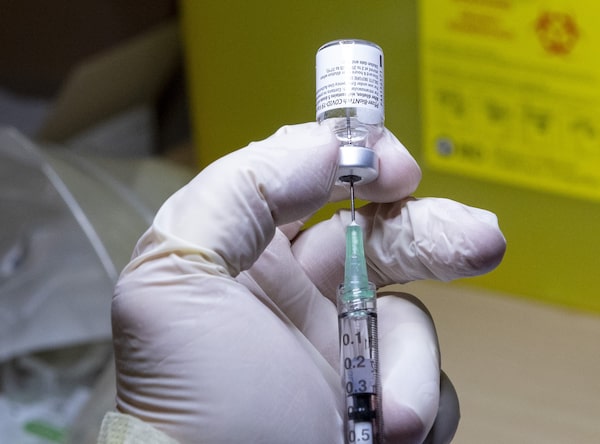
The first Pfizer-BioNTech COVID-19 vaccine dose in Canada is prepared at The Michener Institute in Toronto on Dec. 14, 2020.Frank Gunn/The Canadian Press
Hey, Ottawa, I know you’ve earmarked as much as $100-billion to revive the pandemic-battered economy over the next three years. I know you’re busily thinking up plans on how best to put that money to work.
Let me just say, as a concerned citizen and professional economic worrier: If you want to throw it all at getting vaccines into arms, I’m all for it. Starting, like, yesterday.
Okay, I know that the ramp-up of vaccinations is bound by some supply and logistical limitations that aren’t necessarily solved by simply throwing a mountain of taxpayer cash at them. But to the extent that maximizing our federal and provincial resources – financial and otherwise – on vaccine programs would speed things up, this must be our focus. It is far and away our best bet for getting the economy back on its feet, and limiting the potential economic scarring from the second wave of the pandemic. Not to mention, you know, saving human lives.
The economic outlook entirely hinges on the vaccine rollout. Anything else our governments have up their sleeves to repair the pandemic-fractured economy flows from it. Nothing can be fixed until we get the country vaccinated.
Economists at a couple of Canada’s biggest financial institutions underlined that point last week, even as COVID-19 cases soared in parts of Canada and provincial lawmakers ramped up containment measures.
Bank of Nova Scotia actually raised its 2021 growth forecast to a brisk 4.3 per cent, despite projecting that the second wave would deliver a much bigger setback than previously thought (Scotiabank slashed its first-quarter call from a 3-per-cent annualized growth pace to a 2.1-per-cent contraction). Similarly, Canadian Imperial Bank of Commerce held its 2021 growth forecast steady at 4 per cent, despite slashing its first-quarter call to a 2-per-cent annualized decline.
“While we’ve been forced to lower our expectations for the first quarter of 2021, much like pulling on a rubber band a bit further, there’s reason to believe that it will be made up with a faster bounce-back later in 2021,” CIBC senior economist Royce Mendes wrote in a report last week.
“That outlook, admittedly, relies heavily on a mass vaccination effort that accelerates to match the expectations of the federal government.”
Ah, there’s the rub.
Federal officials confirmed last week that vaccine shipments from producers Pfizer and Moderna won’t reach full speed – roughly a million vaccine doses a week – until April. Stephen Brown, senior Canada economist at Capital Economics, said in a report Friday that Canada looks on track to deliver a first dose to about 9 per cent of its population by the end of February – well behind the pace of Group of Seven peers Britain and the United States. He estimated that Canada won’t even receive enough doses to fully vaccinate the major at-risk groups – two shots each for seniors, long-term care residents and health care workers – until May.
“All this means the economy still has a long few months ahead of it,” Mr. Brown wrote.
Those months could be fatal for small businesses most affected by government-mandated closures and restrictions. A survey by consulting firm KPMG in the fall found that nearly one-third of Canada’s small businesses feared they couldn’t survive a second wave of lockdowns.
That number almost certainly overestimates the degree to which businesses are in trouble; similar surveys in the spring effectively predicted widespread insolvencies from the first lockdowns, and it never happened thanks to a wide net of government financial supports and payment deferrals. Nevertheless, it underlines that the longer the pandemic rages, the more acute the risk is of severe and irreversible economic damage – business failures, loan defaults, job losses.
If we slip into such a scenario, the postpandemic recovery becomes much more difficult, painful – and, for government, expensive. There will literally be less economy left to stimulate.
Yet that risk plummets as soon as the vaccine reaches enough arms to allow business to return to normal, or something close to it. This is about as straightforward an economic scenario as policy-makers will ever face. The vaccine is an economic silver bullet.
Obviously, our leaders at both the federal and provincial level aren’t oblivious to this. And obviously, they are gearing up for a dramatic increase in vaccination rates as supplies gradually increase over the next couple of months.
I would suggest that they use that time to not just prepare, but overprepare. We need to employ the maximum weight of public resources behind the vaccination machinery when it’s time to fully power it up, in the same way we unleashed the full power of government to replace lost incomes and sustain businesses in the pandemic’s first wave last spring.
Throwing the fiscal kitchen sink at the vaccination program will make the job of stimulating the postpandemic economy that much easier, quicker and less costly. It’s the single best economic investment our governments could make.
Your time is valuable. Have the Top Business Headlines newsletter conveniently delivered to your inbox in the morning or evening. Sign up today.
 David Parkinson
David Parkinson